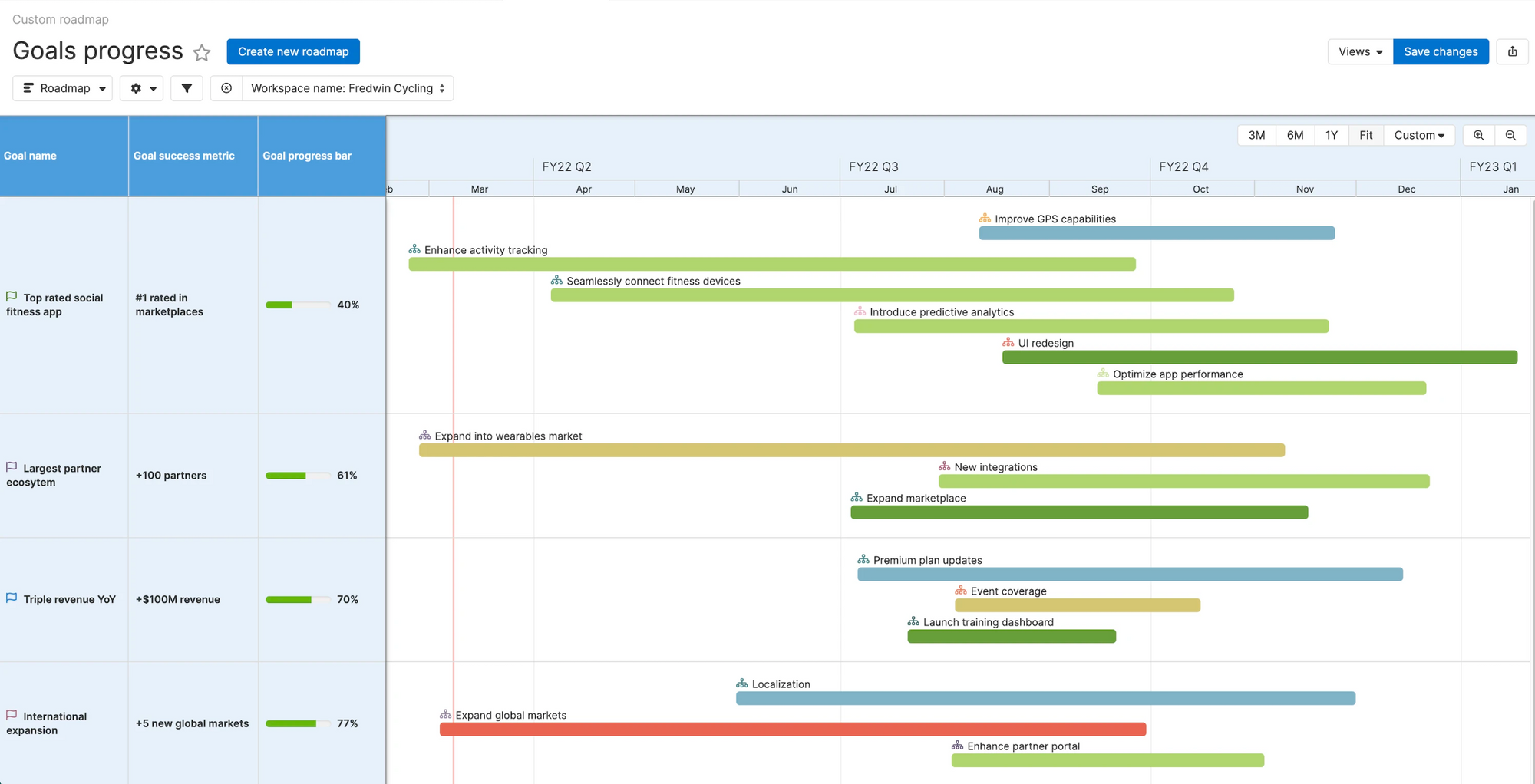Why You Need Both: Product Roadmaps and Product Release Plans

In the ever-evolving landscape of software development and product management, success hinges on effective planning and execution. Two fundamental tools that play a pivotal role in this journey are the "Product Roadmap" and the "Product Release Plan." These indispensable instruments are often used interchangeably, which can often lead to confusion. Understanding the nuances and significance of each is critical for steering your product towards triumph.
In this blog, we'll unravel the reasons why you need both of these strategic frameworks to navigate the complexities of creating exceptional products, and define the unique characteristics and purposes of each.
The Product Roadmap: your foundation
In the context of product development, a well-crafted product roadmap serves as a guiding compass, providing a clear and visual representation of the journey from concept to fruition. It is a strategic blueprint that outlines the vision, goals, and planned initiatives for the product over a specific timeframe, often spanning months or even years. The primary purpose of a product roadmap is to align all company teams, from product management and development to marketing and sales, behind a shared vision and common goal.
By offering a comprehensive overview of the product's evolution, a product roadmap ensures that all stakeholders are on the same page regarding the product's direction. It establishes a coherent narrative, highlighting the key features and enhancements that will cater to customer needs and market demands. This alignment fosters collaboration and synergy among teams as they unite their efforts towards a collective mission. Consequently, a well-communicated product roadmap instills a sense of purpose and direction, minimizes conflicts, and maximizes efficiency.
Check out this piece on the Merit Blog about how to make a great product roadmap.

A product roadmap might look something like this. [source]
The roadmap is also a powerful communication tool, facilitating discussions with internal teams, external stakeholders, and customers alike. It gives product managers the tools articulate the product's strategic direction, justify resource allocation, and manage expectations effectively. Additionally, it enables open dialogue with customers, garnering valuable feedback to validate and refine the product's vision. Through transparent communication and continuous feedback loops, a product roadmap evolves organically, adapting to changing market dynamics and customer preferences, thereby increasing the product's chances of success in a competitive landscape.
“I think of roadmaps as communication vehicles rather than decision vehicles,” says tech start-up veteran and product management thought leader Rich Minronov. “A lot of folks say their goal is to have a roadmap. And I say no, our goal is to have a good product strategy where we make hard choices and prioritize the right things. The roadmap is simply a reflection of this.”
In essence, a well-structured and thoughtfully communicated product roadmap is the backbone of successful product development. The roadmap becomes the rallying point that inspires and motivates teams, propelling them towards delivering a product that not only meets customer expectations but exceeds them.
The Product Release Plan: your tools
Meanwhile, a product release plan translates the strategic vision outlined in the product roadmap into actionable steps and timelines. While the product roadmap sets the long-term direction and goals, the product release plan drills down into the nitty-gritty details, providing an execution-level plan for delivering the planned features and improvements. This tactical roadmap acts as a compass for the development team, guiding them through the journey of bringing the product to life in a structured and efficient manner.
The primary purpose of a product release plan is to ensure that the work outlined in the product roadmap is executed effectively and on time. It lays out the specific features and enhancements that will be included in each release, breaking them down into manageable tasks with clear deadlines and objectives. By doing so, a release plan empowers the development team to prioritize their efforts, allocate resources efficiently, and maintain focus on the tasks at hand. This level of organization and clarity reduces the risk of scope creep and helps the team stay on track towards achieving the product's strategic goals.
Check these tips for writing a good product release plan.

This diagram shows an example product release plan. [source]
Just as a product roadmap is critical for communication and coordination, the release plan sets clear expectations for each phase of the project, allowing stakeholders to understand what features will be available at specific points in time. This transparency fosters trust and collaboration among team members and helps manage external stakeholders' expectations. For instance, the roadmap would often be communicated to the sales and marketing teams at a certain phase of development, so that they can plan and execute their functions accordingly. With a cohesive release plan in place, the entire organization can work in sync, driving the product development process towards successful and timely releases.
In summary, a product release plan is a crucial component of the product development process, providing the tools for turning strategic intentions into tangible deliverables. By mapping out the "how," "who," and "when" of feature delivery, a release plan ensures efficient execution and coordination across teams. It encourages the teams and individuals involved to align efforts, optimize resource allocation, and deliver a product that meets customers' needs and expectations while staying ahead of the competition in the market.
Who Does What?
We’ve established that both the product roadmap and the release plan require (and enable) collaboration and coordination across many roles and teams. However, it’s also important to specify who gets involved at each stage of the product’s strategic lifecycle. (Check this blog post for more context on the overall timeline and planning horizons for both tools). While there is, of course, variance depending on a company’s size, structure, and development process, the following split is common when developing these product plans:
Roles that build the Product Roadmap:
- Product Manager: Product managers define the product vision, uncover customer needs, and prioritizing features and improvements based on market research and business objectives. Product managers collaborate with stakeholders, including executives, customers, sales, marketing, and development teams, to create a cohesive and customer-centric product roadmap. Smaller companies might sometimes have the CTO or Tech Lead, or even the CEO, play this role, as well.
- Product Owner/Manager: This role is responsible for maintaining the product backlog, refining user stories, and ensuring that the product roadmap aligns with the team's capacity and priorities.
- UX/UI Designers: This team contributes to the product roadmap by advocating for user-centered design and suggesting user experience improvements. Their insights help prioritize features that enhance usability and align with the overall product vision.
Roles that work on the Product Release Plan:
- Development Team: The development team, including software engineers, developers, and QA testers, is actively involved in creating the product release plan. They work closely with product managers and product owners to understand the scope of work, estimate the effort required for each feature, and plan the implementation and testing phases.
- Scrum Master: The Scrum Master collaborates with the development team to plan and execute product releases. They facilitate the team's efforts, remove impediments, and ensure that the release plan aligns with the team’s capacity.
- Project Manager: In some organizations, a project manager might be responsible for overseeing the execution of product releases. They coordinate with different teams, monitor progress, manage risks, and ensure that the release plan stays on track.
- Marketing and Sales Teams: While not directly involved in building the release plan, marketing and sales teams play an essential role in its execution. They align their marketing and sales strategies with the planned product releases to maximize product launch impact and communicate effectively with customers and prospects.
The Merit blog has several pieces clarifying the distinctions between roles that are worth checking, should you desire more context:
How a Roadmap and a Release Plan Work Together to Build a Strong Product
The marriage of a well-crafted product roadmap and a meticulously planned product release plan becomes the driving force behind a successful project. Together, these two strategic tools form a powerful duo, complementing each other to maximize efficiency, alignment, and innovation. While the product roadmap sets the vision, goals, and customer-centric features, the product release plan breathes life into those aspirations, transforming them into actionable steps and specific timelines.
Here is a simplified overview of the split between them:
| Roadmap | Release plan |
|---|---|
| High-level overview, describes the journey | Zoomed in, detailed view of the specific steps |
| Covers a longer time frame—usually about 12 months | Covers a shorter time frame—usually 3–6 months |
| Often used to communicate with stakeholders like executives and customer-facing teams | Often used to create alignment between product and engineering teams |
| Focuses on why you’re doing something based on user insights and strategy | Focuses on what you’re doing and when you’re committing to having it completed |
The product roadmap serves as the compass, guiding the entire organization towards a shared destination. By uniting all company teams behind a common goal, it fosters collaboration and ensures that efforts are synchronized, minimizing conflicts and streamlining workflows. This clear and comprehensive vision acts as a north star, inspiring creativity and innovation while staying aligned with market needs and customer expectations.
The product release plan forms the execution-level roadmap, paving the way for feature delivery and product iterations. It provides the development team with the path to success, breaking down the product roadmap into manageable tasks and timelines. By setting clear objectives and deadlines, the release plan empowers the team to stay on track, maintain focus, and deliver each release efficiently. Through effective communication and coordination, the release plan keeps all stakeholders informed and involved, driving the project forward with precision.
Simply, release plans answer tactical questions like, "are we on track to meet our goals?" while roadmaps answer strategic questions such as, "where do we want to go, any why?"
Both tools are indispensable halves of a successful product development journey. Together, they create a holistic approach that fosters innovation, customer satisfaction, and organizational alignment, culminating in the realization of a product that stands out in the market.
Speak with tech professionals across the product lifespan by scheduling a session with Merit:
